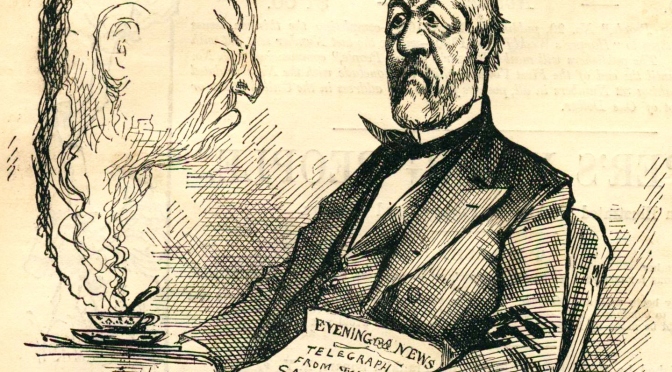
Republican presidential hopeful James G. Blaine was all too aware that Nast’s sphere of influence on the electorate was wide. Nast relished exposing Blaine’s hypocrisy and anti-immigration stance. East Coast, New England tolerance toward accepting newcomers had been a point of Republican pride. Blaine was the first Republican official to defect to the Democratic way of thinking. Nast’s fixation on Blaine was unrelenting, and nearly equaled his Tweed/Tammany days. The attention worried Blaine, who “attempted to explain and to justify his position, but the artist could see in the Chinese immigrant only a man and a brother, trying to make a living in a quiet and peaceful manner in a country that was big enough for all” (Paine, 413).
Nast’s Blaine’s Teas(e) shows the dilemma the politician faced. The Evening News Blaine reads, chronicles the West Coast’s growing calls for “The Chinese Must Go.” A savvy politician, Blaine needed votes in the West. All the while working to undermine the legitimacy of Chinese Americans, Nast lets Americans see that Blaine enjoyed the teas and porcelains resulting from U.S. trade with China. Nast calls out hypocrisy and incongruity of admiring Chinese “things” but hating the source of the objects.
The clammy Chinese figure rising before Blaine’s conjures the haunting, ethereal quality of ghosts who confront Dickens’ Scrooge. Whether Dickens’s spirits were an inspiration is unknown. Blaine is visited, in this instance, by a hot steamy specter who rises up from Blaine’s teacup to scold and confront the politician. This apparition will not allow Blaine to enjoy his tea in peace and privacy. Blaine’s hair appears to rise in alarm, but Blaine looks more annoyed that fearful. His right hand has gripped the paper suddenly, indicating he is unnerved, yet he continues to clutch at his truth as he comes to terms with what is before him. Otherworldly, and celestial, the Chinese tea ghost peers directly into Blaine’s eyes with and bears a stiff upper lip.
The cartoon asks a question, which in a century and a half later, Lenore Metrick-Chen made the focus of her book Collecting Objects/Excluding People. “What happens when the exotic refuses to remain our fantasy, our abstraction and instead intrudes into our space?”(1)
Nast’s ghost intrudes, haunts and teases Blaine with the reality of the politician’s actions and xenophobic policies. Nast challenges the worthiness of Blaine’s Republican ideals – his obligation as a member of Lincoln’s Party to tolerate newcomers to the United States.
Nast confronts a reality that Metrick-Chen continues to wrestle with and unpack in her book. Throughout America’s earliest history, spanning across Nast’s era and well into the twentieth century, American and Western culture held a fascination with exotic Eastern objects and artifacts. Blaine wants to enjoy his Chinese tea from Chinese porcelain. He embodies exactly the kind of person who collects objects but excludes people. Nast reminds his audience, and Blaine, that the Chinese people created these cherished goods and services. Blaine deserves to be haunted by his hypocrisy.

Nast’s idea for this cartoon, however, may not be original. A “spectral disembodied head emerges from a magic lamp” in John S. Cook’s 1870 illustration of Money vs.Muscle, or Chinese Emigration. To the Workmen and Trade unions of America, published by the Season Press. It is not known if Nast had access to the book. The images are strikingly similar.
Metrick-Chen writes that soon after the United States was formally recognized as a country under the terms of the Treaty of Paris, the U.S. eagerly entered into trade with China. “The predominant American view of the Chinese had been laudatory” (19).
With the conclusion of The Opium War (1839- 1842), American superiority (Manifest Destiny) grew. Reports from Protestant missionaries stationed in China relayed to the American people their unsuccessful attempts to convert the Chinese to Christianity. These reports making their way home factored in supplanting favorable views toward China into negative opinions (Metrick-Chen 21-23). Defining Chinese as non-Christian heathens was an important element in disqualifying them as competitive laborers and applicants as citizens and visitors to the U.S.


One thought on ““Blaine’s Teas(e)” – 20 March, 1880”